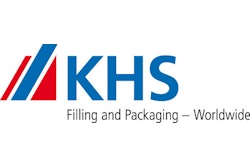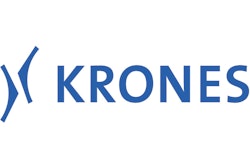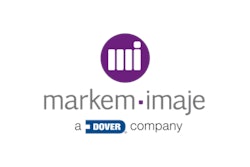It’s the sheer size of the Sidel Combi blow/fill/cap system that registers first when a visitor encounters the new PET bottling line at Coca-Cola Enterprises in Toulouse, France. That and the remarkable number of bottles sailing down their various conveyor connections.
The Combi has 20 blowing stations, 160 filling nozzles, and 20 capping stations. As Sidel’s Clive Barnes puts it, “There’s an awful lot of product flowing through that filler.”
And yet, ironically enough, it was the Combi’s compactness that appealed to the CCE engineers who were responsible for commissioning the new line. Toulouse operations manager Arnaud Perrin makes this quite clear.
“The layout for the new line was a real challenge in itself, since no expansion of the plant was planned for this new production line,” says Perrin. “Only a few inside walls were knocked down. In light of these layout constraints, we opted for the Sidel Combi partly because of its compactness, since its blowing and filling functions are closer to each other than in machines from other manufacturers.”
With this investment, CCE aims to keep up with increased demand for carbonated soft drinks in southwestern France. The line also lets CCE produce 500-mL bottles at two sites in France instead of only at its plant near Paris. Total annual production capacity at the Toulouse facility is now 200 million bottles.
Making the installation of the new line even more remarkable is the timeline behind it. The decision to go ahead with the new line was made in October, 2008. By May 5 the line was installed and running.
Complex project
“This was a complex project,” says Perrin, “which included such challenges as a very tight time frame, rethinking factory layout without expanding the site, and learning the Combi blow/fill technology. Close collaboration between Coca-Cola and Sidel enabled us to put in place an organization and an extremely precise schedule with milestones to check that we stayed on schedule. We created a dedicated project team, half of whom were experts from CCE Europe and the other half from CCE Toulouse. Each team member had his or her own responsibilities: engineering projects, installation of utilities, equipment delivery, and operator training.”
A prerequisite for CCE was to install a flexible line that could blow a variety of bottle sizes and fill a number of products. That means three bottle sizes (500-mL, 1.5-L, and 2-L), 14 flavors, and a total of seven bottle formats, including not just the familiar Coca-Cola shape but also the dimpled Sprite bottle, the Fanta Splash bottle, and the Coke Zero bottle.
“Line flexibility,” says Perrin, “was one of the decisive factors in equipment selection. We wanted short production cycles and frequent format changeovers, while guaranteeing line efficiency greater than 80%. High performance was our objective.”
Format changeovers are mostly automated with the Combi, including adjustment of the bottle input star wheels in the capper and automatic dummy bottles to clean the product circuits. “Thanks to flowmeter filling, it is very easy to change a value on a single nozzle from the control station without stopping the machine,” says Perrin. “To change from one bottle size to another, about three and a half hours are needed to clean the machines and change all the parts for format and recipe changeovers.”
One thing helping to keep changeovers simple and fast is that the preform shape is always constant. For larger bottles, a 45-g preform is used while smaller bottles get a 40-g preform. But length and diameter of the preform do not change.
Small but mighty
“At 45,000 square meters, this is a small plant by CCE standards,” says Perrin. “Despite its modest size, we wanted the plant to be as cost effective and efficient as any other CCE plant. Goals for speed on this new line were 24,000 per hour for 2-L, 32,000 per hour in 1.5-L, and 36,000 for 500-mL.”
CCE took a tripartite view of the new line: processing, packaging, and end of line. “In each section, we wanted best in class,” says Perrin. This led them to KHS for processing, Sidel for blow/fill/cap/label, and Krones for shrink bundling and palletizing.
“We didn’t add on to the facility, but the transformation was so extensive that it was almost like creating a new plant,” says Perrin. “We used some space formerly used for raw materials and finished goods.”
In driving the efficiencies that were deemed necessary, CCE borrowed liberally from the world’s leading lean manufacturing methodologies, especially where rapid changeover is concerned. “Now that the line is producing commercial product, we’re working on improving efficiencies in a number of areas, and a further reduction in changeover time is one of them,” says Perrin.
Automation’s role
“Automation is a huge part of efficiency in a line like this, and our goal here was to be able to operate this line with only two people plus one support,” says Perrin. “One person is dedicated to the Combi and the other to the end of line. We want them to avoid manual control and handling. The Sidel technology automates the measurement of torque and bottle weights, so that’s one thing our people don’t have to worry about in any kind of manual way. We also have new tools in place to measure cap color, volume in the bottle, the presence of the batch code, and so on. In the past these things were done manually every 20 minutes or so. Not with this line.”
The commitment to automation on the new line is so fundamental that CCE doesn’t even use the word “operator” to describe the people on the plant floor. “We prefer ‘pilot’ to ‘operator,’” says Perrin. “We want them to pilot the process. Automation is what lets us run the line with two people. On previous lines we might need four people plus one support instead of two plus one support.
“Another key thing we wanted here on the new line was automated changeover. The capper, for example, requires no manual intervention. Everything is automated. Servo motors and software make this possible. You select from a menu, and then guide rails, capper heights, and so on are all changed automatically. Cleaning, too. Even the false bottle for cleaning is put in place automatically instead of manually.” Perrin also notes that the standardized control interface throughout the Sidel portion of the line is a huge help. “With the same look and feel at the HMI on the blow molder, the filler, the capper, and the labeler, it becomes much easier to train people and to improve machine efficiency,” says Perrin.
One thing noticeable immediately is the lack of sudsy water that is so commonly used in most bottling plants on the conveyor connections where full bottles are being transported.
“Dry lube is a new standard across all CCE units,” says Perrin. “Energy and water savings are important goals, and in this new line we score high marks in both categories.”
Another contribution to sustainable manufacturing is a preform heating oven that is equipped with a heat recovery unit that injects heat back into the plant’s heating circuits. Lightweighting of bottles is also underway. “With technical acceptance of the line behind us, we are going to work on reducing package weight through a shorter neck and lighter cap,” says Perrin. “Then, we’ll look at lightweighting the 1.5- and 2-L bottles, which will require changes in the preform heating process.”
All bottles produced on the new line are given a batch code that is laser printed by a Markem-Imaje system. A short distance downstream from this marking system is a Heuft Spectrum DX inspection system that checks the volume of product in each bottle, cap color, cap position, and the presence and accuracy of the laser batch code. If anything is amiss in any of these categories, that bottle is kicked off the line.
On to labeling
Next in line is a Sidel Rollquattro hot-glue labeler that applies a roll-fed full wrap film label to each bottle. An air knife blows moisture off of the bottles to help ensure smoother label application. Automatic splice capabilities keep downtime between label rolls to an absolute minimum.
Upstream from the labeler is a large accumulation conveyor that can hold about 2,500 bottles. Should the labeler go down for any reason, the accumulation conveyor provides about two minutes of buffer so that the blow/fill/cap Combi can keep churning out bottles. Once the labeler is back in operation, it can run at 38,000/min, so it draws out the bottles in the accumulation conveyor and then returns to its routine operating speed.
After labeling is more accumulation space and then two Krones shrink wrappers. The first Krones wrapper produces unsupported bundles of bottles. On the day of Packaging World’s visit, six 2-L bottles were being bundled. The second Krones bundler, which was not in operation the day of our visit, is used when CCE wants to put six 500-mL bottles in shrink film and then combine four of those six packs in shrink film to form a single unit having a total of 24 bottles. Also not in use the day of our visit is a handle applicator from Twinpack. When customers request a handle, this machine applies one to four- or six-count bundles. Regardless of which format bottles are shrink bundled in, the bundles move next to a spiral conveyor from Ambaflex that takes them to the overhead level and a Krones Robobox palletizer. This machine uses a pair of vision-guided gantry-style robots to constantly arrange bundled bottles in whatever pattern is required.
Immediately downstream from the palletizing system are two Octopus pallet stretch wrappers from Signode. In addition to encasing pallets in stretch film around all four sides and automatically placing corrugated slip sheets between layers, the Octopus units also cut a piece of film from a roll and apply it to the top of each pallet so that the bottles are protected on top as well as on all four sides.
The final operation in the line is performed by a pair of thermal-transfer print-and-apply tamp-style labelers from Logopak. Product code, shelf life, batch number, and a unique identification code is printed on the pressure-sensitive labels that are applied to each stretch-wrapped pallet. A scanner downstream from the labeler scans the bar coded information into CCE’s central warehouse and inventory system. The unique code is scanned again when the pallet goes onto a truck for distribution. This gives CCE a record of when the pallet was produced, for which customer was it destined, and on which truck did it leave. “If any problems should occur,” says Perrin, “we can trace back all the way to raw ingredients that went into the bottles on that pallet. Logopak has become a standard throughout CCE, and they also helped us with development of the track and trace system.”
Looking back at the fast-track installation of the new line, which was CCE’s first experience with blow/fill/cap monoblock technology, Perrin describes it as a project that was exciting not only technologically but also organizationally. “The project team had to focus on so many steps and keep them all synchronized,” he says. “It’s not easy for an organization to do such a thing.”
But as the old saying goes, all’s well that ends well. Says Perrin: “With this experience behind us, we will look for opportunities to install Combi technology where new lines are being considered.”
































